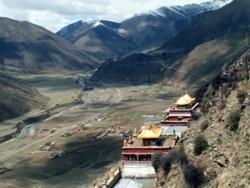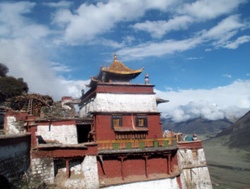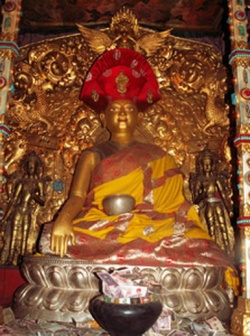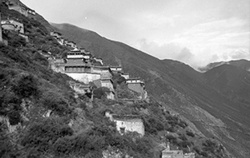Drikung Thil
Drikung Thil Ogmin Jangchubling ('bri gung mthil 'og min byang chub gling) was established in 1179 by Kyobpa Jigten Sumgon ('bri gung skyob pa 'jig rten gsum mgon, 1143-1217), the founder of the Drikung Kagyu tradition. It was actually built at the place of a hermitage erected in 1167 by Minyak Gomring (mi nyag sgom rings), an illiterate ascetic and like Jigten Sumgon a pupil of Phagmodrupa (phag mo gru pa rdo rje rgyal po, 1110-1170).
Drikung Thil is the main seat of the Drikung tradition. It is located on the brow of a long mountain ridge some 120 kilometers to the north-east of Lhasa overlooking the Shorong valley. Legend has it that Jigten Sumgon had selected this place for the monastery while following a dri (a female yak), who lay down at that place. The horns of the dri are still shown today at Drikung. Because of this the whole area supposedly was called Drikung. According to the historical chronicles of Dampa Sonam Gyaltsen (1312-1375) Mirror of the Royal Genealogies (rgyal rabs gsal ba'i me long) in reality the land was a fiefdom of Dri Seru Gungton ('bri se ru gung ston), a minister of King Songtsen Gampo (srong btsan sgam po, ruled 617-649), and the district was named after him.
It is interesting to note that from its founding days Drikung had a very well organized administrative structure. While the abbot was the supreme spiritual authority, the secular administration including civil and military powers were in the hands of a Gompa (sgom pa) or Gomchen (sgom chen). Like the throne holders, most of the secular rulers came from the Kyura (skyu ra) clan, the paternal lineage of Kyobpa Jigten Sumgon. The Kyura clan claimed its descent from king Ralpachen (ral pa can, ruled 815-838). Until the 16th century the throne of Drikung was hereditary among the clan with only very few exceptions.
Historical Developments
During the 13th century Drikung Thil rose to an important center of political power. It became one of the major rivals to the Sakya rule in the period of the Mongol Yuan Dynasty. The power struggle on the background of opposing Mongol groups exerting their influence in Tibet culminated in a military attack on Drikung Thil. This conflict would later go down in history as the war between Drikung and Sakya. It was not a feud between two schools of Tibetan Buddhism, as is often claimed, but rather an attempt on the part of a few provinces of central Tibet to revolt against the overlordship forced on them by Khubilai Khan (1215-1294) with support from rival Mongol groups. The actual local conflict centered on disputes concerning the succession in Phagmodrupa’s monastery of Densa Thil. At Densa Thil branches of the familial lines of the Lang (rlang) clan were pursuing interests that were at variance with each other. One branch was supported by the Sakyapa and the other by the Drikungpa. The war broke out under the 7th lineage holder of Drikung, Tsamche Drakpa Sonam (1238-1286), and in 1290, under his successor Nub Chogo Dorje Yeshe (1223-1293), Drikung Thil Monastery was devastated by Mongolian troops. This disaster did not come unexpected for the local population. As Dorje Yeshe was not a member of the Kyura clan, but of the Nub clan, he lacked support in difficult times, since Jigten Sumgon had prophesied that choosing a throne holder outside the Kyura clan}} would bring misfortune to Drikung.
Drikung Thil was rebuilt under the 9th lineage holder, Chunyi Dorje Rinchen (1278-1314), with support from the Emperor and the Sakyapa. But the powerful influence that the monastery had exercised for decades in Tibet was gone. After this period of decline in political influence, Drikung Thil slowly regained its prominence and became an important intermediary in Sino-Tibetan relations throughout the Ming Dynasty (1368-1644).
The Buildings and Shrine Rooms
From the beginning Drikung Thil was and still remains one of the preeminent Kagyu centers of study, tantric teaching, and retreat. Up until the 19th century, the main emphasis was on rituals, practice, and religious dances. Kyobpa Jigten Sumgon stressed that his line should follow the view of Mahamudra and the conduct of the training in higher ethical self-discipline. Subsequently, the monks’ discipline at Drikung Thil has always been very strict. Following its destruction during the Chinese occupation Drikung Thil has been undergoing reconstruction since 1983. Before its abandonment in 1959 and subsequent ruin, the monastery housed about four hundred monks, sixty meditation practitioners, six Lama’s residences (bla brang), and eight incarnate Lamas.
The main shrine hall, the Tsuglakhang (gtsug lag khang), with the large terrace in front of it, is built on a solid stone rampart about twenty meters high. On this terrace Jigten Sumgon and many of his followers on the seat of Drikung used to give instructions to the monks in the winter time dressed only in a light cotton garment. Scattered on the ridge are numerous smaller buildings, rustic hermitages serving as meditation cells of the Eastern (sgrub grwa shar) and Western Practice Colleges (sgrub grwa nub). The buildings dispersed on different levels are joined by steep stone steps and in some cases by wooden ladders.
The treasures that were kept in no less than fifteen temples of the monastery (seven of which have been since rebuilt) in ancient times bear evidence of the prominence of Drikung Thil. The most important of these Lhakhangs (shrine rooms) is the so called Golden Temple (gser khang), filled with remarkable statues and stupas. The central figure in the Golden Temple is an effigy of Kyobpa Jigten Sumgon made of gold and copper in his likeness ('dra sku) and filled with numerous rare relics and jewels.
The third shrine room housed another very famous statue of Jigten Sumgon. The story goes that Jigten Sumgon once was angry at his monks and left the monastery for a secluded retreat in the Tsaug cave (tsha 'ug dpal gyi nags khrod). This was at the time when his fame was spreading wide and he was said to have had 180.000 pupils. His students begged him to return and offered countless khatags. These white silk scarves were eventually burned and the ashes were mixed with ground jewels. From this mixture a statue in the likeness of Jigten Sumgon was built, called Darkuma (dar sku ma) which became very famous.
The renowned Red Earth Throne (sa khri dmar po) of Kyobpa Jigten Sumgon can be found in the fourth Lhakhang, surrounded by elaborate paintings of the Kagyu Lineage Lamas, Yidams and protectors on the walls. Adjacent to this shrine room is the assembly hall and in front of it a place called Nela Yelthang (gnas bla g.yel thang), which is the main place for pujas and teachings by Lamas and Rinpoches. According to a prophecy by Jigten Sumgon, whoever sets a foot on this place will not be reborn in the Lower Realms.
Sky Burial Ground (Drikung Durto)
On the shoulder of the mountain west of Drikung Thil lies Drikung Durto ('bri gung dur khrod), the renowned sky burial ground, compared in fame to Sitavana (bsil ba tshal) near Bodh Gaya, one of the eight Indian charnel grounds. Still today bodies are brought from far away places in Tibet for being dismembered and fed to the vultures at Drikung Durto. According to legend a rainbow joins Sitavana with the sky burial ground of Drikung. A vulture's footprint in stone still to be seen here is said to belong to Sitavana’s protector. Part of the boundary around the place with stupas and lhakhangs is also a circle of boulders representing the mandala of Chakrasamvara ('khor lo bde mchog). There is also a self-arisen mani-stone and a stupa that marks the place of Jigten Sumgon’s throne with his footprint in rock.



